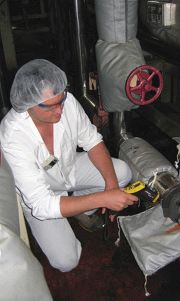 Grant Bailey of Thermal Energy International (TEI) looks at energy losses related to the use of steam and the most effective methods of minimising this wastage.
Grant Bailey of Thermal Energy International (TEI) looks at energy losses related to the use of steam and the most effective methods of minimising this wastage.
Steam is typically used for a wide range of applications within larger establishments including, humidification, hot water, space heating and air heating. Primary energy losses in a steam system account for 40% of losses and can be broken down as shown in the table (right). Therefore, of the money spent on producing steam each year around 45% is lost, when up to 40% could be recovered.
Steam traps
A steam trap is a device that discharges condensate and air from the line or piece of equipment without discharging the steam. The three important functions of a steam trap are to discharge condensate as soon as it is formed, not to allow steam to escape, and to be capable of discharging air and other condensable gases.
However, around ten percent of mechanical steam traps will fail each year. Traps that fail ‘open’ result in a loss of steam and its energy. Where condensate is not returned, the water is lost as well. The result is significant economic loss, directly via increased boiler plant costs, and potentially indirectly via decreased steam heat capacity. Steam leakage is a visible indicator of waste and accounts for up to 11% of steam consumption in a small or medium scale industry, rising up to an astonishing 55% in high usage processing industries.
Steam traps need to be working at optimum efficiency with a minimum impact on the environment. For example, for each litre of heavy fuel oil burned unnecessarily to compensate for a steam leak, approximately 3kg of CO2 is emitted to the atmosphere. Steam traps can have different sized orifices to suit different conditions. If a trap leaks steam, the amount wasted will depend on the size of the trap and the steam pressure.
There are numerous steam traps available and selecting the correct type of steam trap is an important element of any steam system. Whilst mechanical traps are extensively used, the fixed orifice condense discharge trap is now becoming the steam trap of choice. Instead of utilising a valve mechanism to close off steam, the venturi orifice design effectively drains condensate from the steam system, for maximum energy and water conservation. As these steam traps have no moving parts to wedge open or fail, they provide the ultimate in reliability, requiring only minimal maintenance and no spares, testing or monitoring equipment. They are available in a range of options for specific applications, manufactured from corrosion resistant stainless steel and are performance guaranteed for ten years.
 Hospitals
Hospitals
Hospitals are an example where the fuel efficiency of boiler operations can be improved by using technology that converts an industrial boiler into a condensing boiler. Products like TEI’s FLU-ACE effectively recovers up to 100% of the heat normally lost through the boilers exhaust flue. This is possible because of a direct contact (gas/liquid) design and enables optimal recovery of both sensible and latent heat, even in widely varying operating conditions.
Cold water travels from the spray nozzle and counter flows the rising hot flue gas through the stainless steel transfer media. As the water droplets travel through the media, the flue gas rises to the top of the economiser preheating the water. Final heating of the water takes place in the direct contact chamber. A transfer pump or gravity can then move the preheated water to a hot water storage system, ready to deploy to a nearby user.
Conventional heat recovery technologies require dedicated equipment for each boiler exhaust. However, a single FLU-ACE can handle a varying flow of flue gases emitted from multiple boilers. This results in a lower initial investment, lower operating costs and a higher return on investment. A full payback is achieved, usually in less than two years with continuing savings being maintained throughout the unit’s 20+ year operating life.
Gas fired boilers send approximately 18% of their consumed energy out of the exhaust stack which, along with other losses from the system means that for every pound spent only 55p of energy is actually being utilised. This lost heat can be regained by using a FLU-ACE Stack Economiser where the boiler efficiency can then be brought up to 100%. When used in combination with the GEM traps this reduces waste to as low as 17% providing an extra 28p of energy from every pound spent or delivering 50% more energy for your money.
With the clock ticking on the NHS to meet carbon emission targets of 15% by the end of this year, estate managers will be more than able to meet this target with steam system modernisation. This will not only have a beneficial affect on the environment but also on NHS finances.
Unfortunately, when it comes to steam traps and boiler steam loss, people often ignore them. This complacency is costing steam users much more than they realise. The hard reality of a plant maintaining its boiler and forgetting about the rest of the steam system can be a horribly wasteful proposition. Losses can include not only wasted energy but also replacement of damaged equipment and misuse of man hours. Fortunately, installing low maintenance orifice venturi steam traps can avert much of these potential losses.


